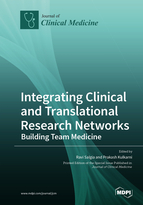Integrating Clinical and Translational Research Networks—Building Team Medicine
A special issue of Journal of Clinical Medicine (ISSN 2077-0383). This special issue belongs to the section "Clinical Laboratory Medicine".
Deadline for manuscript submissions: closed (31 July 2020) | Viewed by 49271
Special Issue Editors
Interests: lung cancer; thoracic oncology
Special Issues, Collections and Topics in MDPI journals
Interests: cancer systems biology; evolution; non-genetic mechanisms; intrinsically disordered proteins
Special Issues, Collections and Topics in MDPI journals
Special Issue Information
Dear Colleagues,
Academic medical centers are widely recognized as vital components of the American health care system. However, community hospitals fill a critical need and play a complementary role serving as the primary sites for health care in most communities. New health care reform initiatives and economic pressures have created incentives for hospitals and health systems to integrate, resulting in a nationwide trend toward consolidation with academic medical centers leveraging their substantial assets to merge, acquire, or establish partnerships with their community peers with the ultimate goal of ensuring that all patients regardless of their physical proximity to major medical institutions can benefit from recent clinical advances. Further, it is increasingly evident that scientists also contribute significantly to the emerging inter- and cross-disciplinary, team-oriented culture of translational science. Therefore, approaches that leverage the combined knowledge, skills, experience, expertise, and vision of clinicians in academic medical centers and their affiliated community centers and hospitals, together with those of basic research scientists, are critical in shaping the emerging culture of translational research. Today, the success of academic-community collaborative programs depends on ‘Team Medicine’. In this Special Issue, we present the City of Hope Team Medicine experience in achieving this goal in medical oncology.
Dr. Ravi Salgia
Prof. Dr. Prakash Kulkarni
Guest Editors
Manuscript Submission Information
Manuscripts should be submitted online at www.mdpi.com by registering and logging in to this website. Once you are registered, click here to go to the submission form. Manuscripts can be submitted until the deadline. All submissions that pass pre-check are peer-reviewed. Accepted papers will be published continuously in the journal (as soon as accepted) and will be listed together on the special issue website. Research articles, review articles as well as short communications are invited. For planned papers, a title and short abstract (about 100 words) can be sent to the Editorial Office for announcement on this website.
Submitted manuscripts should not have been published previously, nor be under consideration for publication elsewhere (except conference proceedings papers). All manuscripts are thoroughly refereed through a single-blind peer-review process. A guide for authors and other relevant information for submission of manuscripts is available on the Instructions for Authors page. Journal of Clinical Medicine is an international peer-reviewed open access semimonthly journal published by MDPI.
Please visit the Instructions for Authors page before submitting a manuscript. The Article Processing Charge (APC) for publication in this open access journal is 2600 CHF (Swiss Francs). Submitted papers should be well formatted and use good English. Authors may use MDPI's English editing service prior to publication or during author revisions.
Keywords
- Translational research
- Team Medicine
- Health care reform
- Clinical advances
- Emerging inter- and cross-disciplinary
- Team-oriented culture








